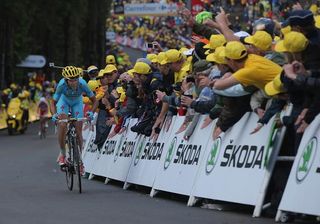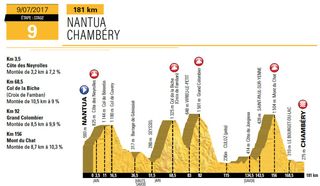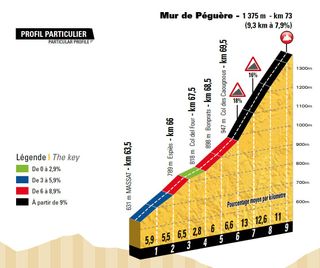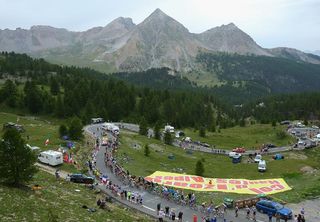Tour de France 2017: 5 key stages
Summit finishes, penultimate-day TT, extreme gradients and a compact mountain thriller







Whereas the Alps stood out starkly on the route of this year's Tour de France, with four demanding back-to-back days in the mountains, it is rather more difficult to ascertain the decisive portion of the 2017 route.
Unveiling the parcours in Paris on Tuesday, race director Christian Prudhomme outlined his desire to break free from the 'catenaccio' of recent editions and achieve "an unpredictable Tour de France, where the race can be at stake on any given day".
To that end he has offered relatively light smatterings of summit finishes (three) and time trial kilometres (36), while introducing steeper climbs and spreading them across the three weeks and all five of France's mountain ranges.
Despite the emphasis on subtlety and balance, there are some key stages that stand out, and Cyclingnews picks out the ones that could see fireworks in Prudhomme's desired open' battle for the yellow jersey.
Stage 5: Vittel to La Planche des Belles Filles (160km)
The short opening-day time trial will have established an initial hierarchy, but the first true blows in the battle between the overall favourites will be traded on La Planche des Belles Filles, the race's first summit finish.
The climb holds good memories for 2016 champion Chris Froome, who took the first Tour stage of his career there in 2012, while Vincenzo Nibali was triumphant on the only other visit in 2014. There's not much to worry about ahead of the final climb but the double-digit gradients, which turn to 20 per cent near the top, are an example of the emphasis on steeper slopes in the 2017 Tour.
With an average gradient of 8.5 per cent over 5.9km, it should provide us with the first reliable general classification sort-out as well as an indication of the true form of the favourites.
Get The Leadout Newsletter
The latest race content, interviews, features, reviews and expert buying guides, direct to your inbox!

Stage 9: Nantua to Chambéry (181km)
More evidence of the steeper gradients here, as the Tour packs Alpine/Pyrenean helpings of elevation gain into a stage through the Jura mountains and towards the Alps.
This is probably the toughest collection of climbs to be found in next year’s Tour, with three hors-categorie ascents in the form of La Biche, the Grand-Colombier, and the Mont du Chat ahead of the hair-raising descent to Chambéry. The stage also starts on a climb, meaning there'll be little chance to ease in to proceedings. Altogether, there are 4,600 metres of elevation gain – equivalent to the Andorra stage of this year’s Tour.
The Col de la Biche is the first big test of the day – 10.5km long at an average of 9 per cent – and it’s soon followed by the Grand Colombier, which was scaled twice in a stage of this year's Tour, won by Jarlinson Pantano. In 2017, however, the riders will, for the first time, scale the climb from the toughest of its four faces, where the gradients ramp up to over 20 per cent in an absolutely brutal middle section.
Thirty kilometres or so separate the Colombier and the Mont du Chat, scene of a memorable tussle between Eddy Merckx and Raymond Poulidor when it last featured back in 1974. After the opening kilometre, the climb barely drops below double digits, and it's steep going down, too, with a tough 12km descent preceding a 10km run-in to the line.
With fewer climbs and summit finishes on the menu this year, along with a penultimate-day time trial to think about, this represents a big opportunity for the pure climbers to impose themselves.

Stage 13: Saint-Girons to Foix (100km)
As Alberto Contador and Nairo Quintana successfully ambushed Chris Froome at this year's Vuelta a Espana, the status of the 'short mountain stage' as cycling's hottest trend was enshrined.
Such parcours, another example of which was the action-packed stage 16 of this year's Giro d'Italia, can make for explosiveness and excitement that's increasingly hard to find on the mammoth slogs. The 2017 Tour is embracing that trend with stage 13, the second in a Pyrenean double-header, which also continues the recent theme of descent finishes.
With just 100km on the menu, and 24km ahead of the first of the day’s three climbs, team mechanics will undoubtedly be unpacking the rollers in Saint-Girons for the riders to get warmed up. There's barely a metre of flat all day, with descents separating the three climbs on the menu – the Col de Latrape, Cold d'Agnes, and the Mur de Péguère.
While the Mur has a lesser average gradient than Agnes (7.9 per cent versus 8.2 per cent), it's the most fearsome prospect on the route. It's average gradient is mitigated by a gentle opening section, but the final 3.3km are exclusively made up of double-digit gradients, with pitches of nearly 20 per cent.
The run to Foix from the top of the climb is a long one (27km) and the descent becomes less steep as it goes along. That means those who go on the attack over the top will have their work cut out, but, as Dan Martin pointed out, anyone on a jours sans – and let's not forget there's a 214km Pyrenean stage and summit finish the day before – could pay heavily.

Stage 19: Briançon to Izoard (178km)
One of the three summit finishes of the race, this was one of the most headline-grabbing stages when the route was unveiled on Tuesday.
The Col d’Izoard needs no introduction, but for first time in its relationship with the Tour, the finish line will be positioned at the lunar landscapes of its summit. It may involve quite a logistical headache, but Prudhomme promised it would provide some of the most spectacular imagery of the entire race. It should also provide some of the most spectacular racing.
"It never ends – it's infinite," Henri Desgrange once said of the 14.1km climb, while Jacques Goddet described it as "a terrible exigency that straddles the difficult and the terrifying."
The climb, which seen some legendary Tour exploits, including Andy Schleck's long solo in 2011, is preceded by the Col de Vars in a two-up set-piece, with both peaks taking riders into the oxygen-deprived heights of 2000+ metres of altitude.
With just three summit finishes on the route, riders can’t afford to wait around on days like this, and Izoard, comfortably the toughest proposition of the three, should see fireworks.

Stage 20: Marseille ITT (23km)
Racing against the clock rarely produces the drama of riders racing against one another but, after a two-year absence, the penultimate-day time trial makes its return, and this 23km Marseille course see the battle for yellow come down to the wire.
Time trials on the eve of Paris have been staple for the Tour in the last 30 years or so, but the format has appeared just once in the past four editions. The Marseille test, however, doesn’t offer the rouleurs the same chance to impose themselves as in years gone by, with the distance limited to just 23 kilometres – compared to an average of 52.5km across the 11 penultimate-day TT’s of the last 15 years.
Romain Bardet had some cheek when asked about the modest total of 36 time trial kilometres in the 2017 Tour and said it was "a lot". In fact, you can't help suspect it was planned that way in order to level the playing field between the 26-year-old, second overall this year, and Froome, as France looks for a first winner of the Tour since Bernard Hinault in 1985.
The course is city-based and starts and finishes in the Stade Vélodrome, home to the Marseille football team. The roads along the Cornice and Old Port are flat but towards the end there's a short punchy climb up to the Notre-Dame-de-la-Garde cathedral that will disrupt the rhythm. It’s not a course that will lend itself to big time gaps, but if it's tight at the top the pressure will be on and it will be one of the most decisive stages of the race.
The length means that someone like Bardet could take yellow into the time trial and, unlike Andy Schleck in 2011, stand a good chance of holding onto it, but if Froome reaches this time trial in the lead, it's hard to not to see him celebrating a fourth title on the Champs Elysées the following day.
Patrick is a freelance sports writer and editor. He’s an NCTJ-accredited journalist with a bachelor’s degree in modern languages (French and Spanish). Patrick worked full-time at Cyclingnews for eight years between 2015 and 2023, latterly as Deputy Editor.
Most Popular


